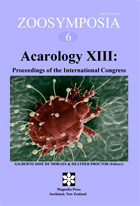Abstract
The coconut mite, Aceria guerreronis Keifer, has emerged as a common menace to most of the coconut plantations in India. After its first upsurge in Kerala at the end of the 1990´s, the mite has spread to many states in southern and northern India, causing considerable damage. Coconut provides one third of the agricultural income in the regions in which it is grown and more than 10 million people are dependent on this cash crop directly or indirectly through coconut-based industries like coir, copra, oil, honey, furniture, handicrafts, beverages, bakery products and so on. The economic instability of the coconut farming community and the people employed in coconut-based industries rank the highest order. A critical assessment of the various problems created by A. guerreronis in the agricultural economy of India is presented in order to supplement data on crop loss through nut malformation, nut fall, loss in fibre and copra. Varietal differences in susceptibility of the plant and future strategies in terms of management practices for an early control of the mite are discussed, and suggestions for future activities to alleviate mite damage are presented.

